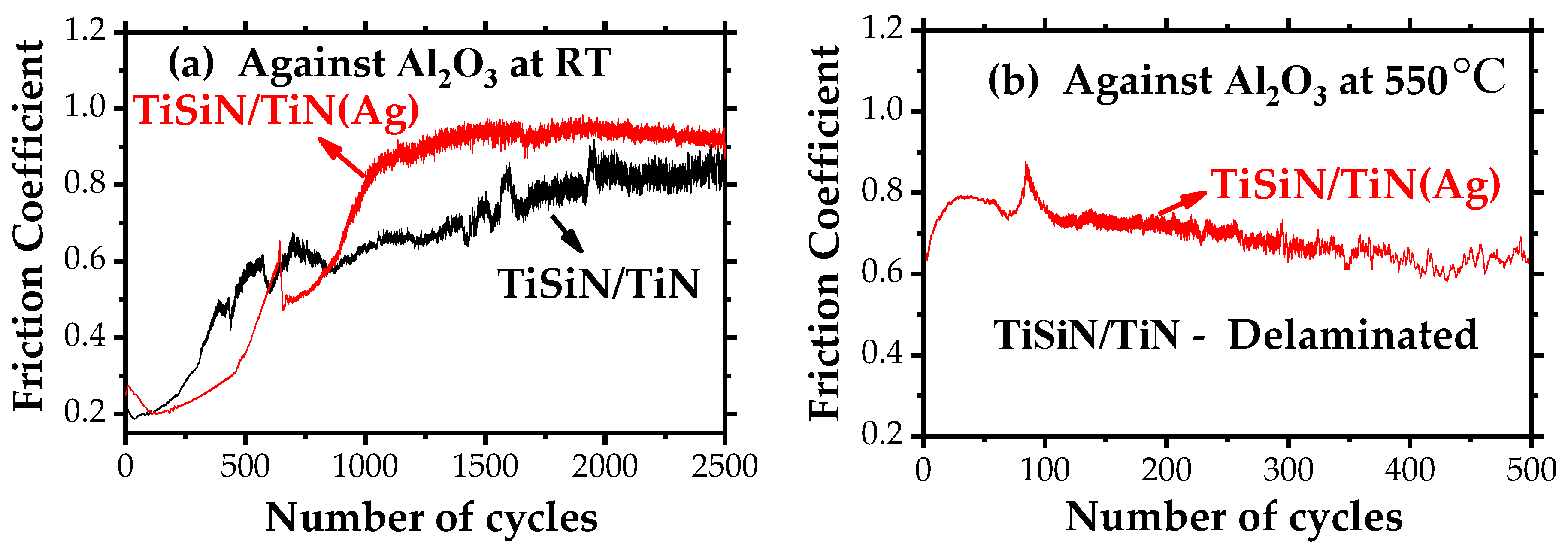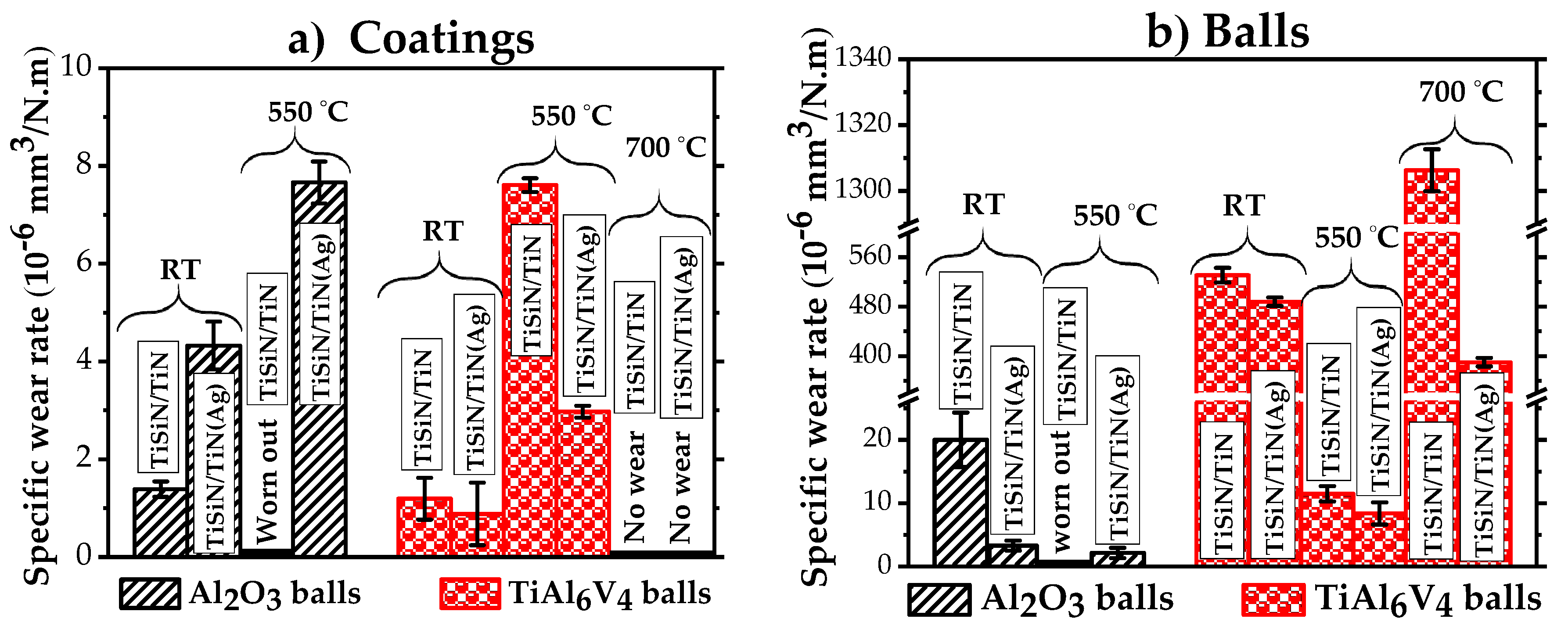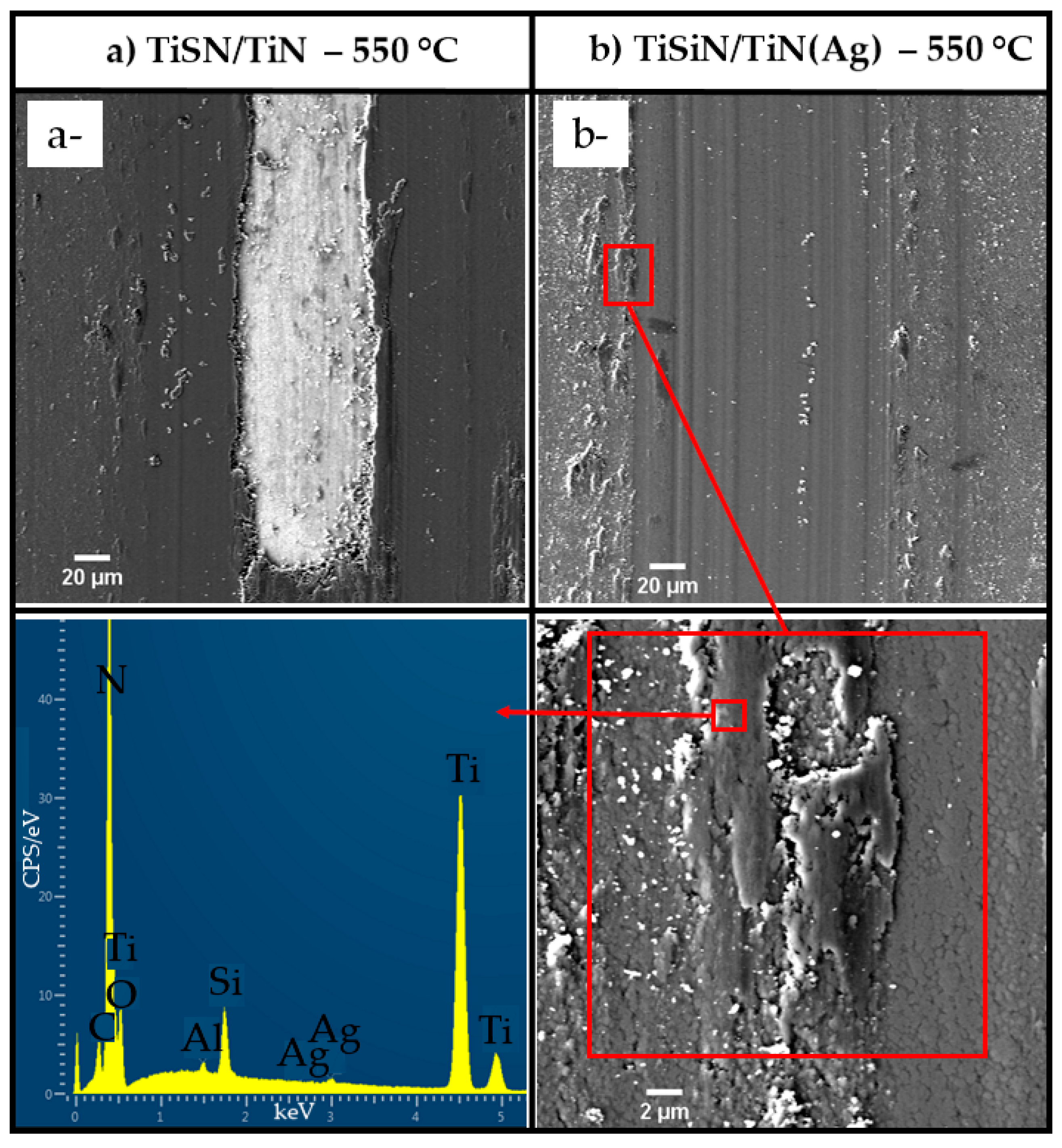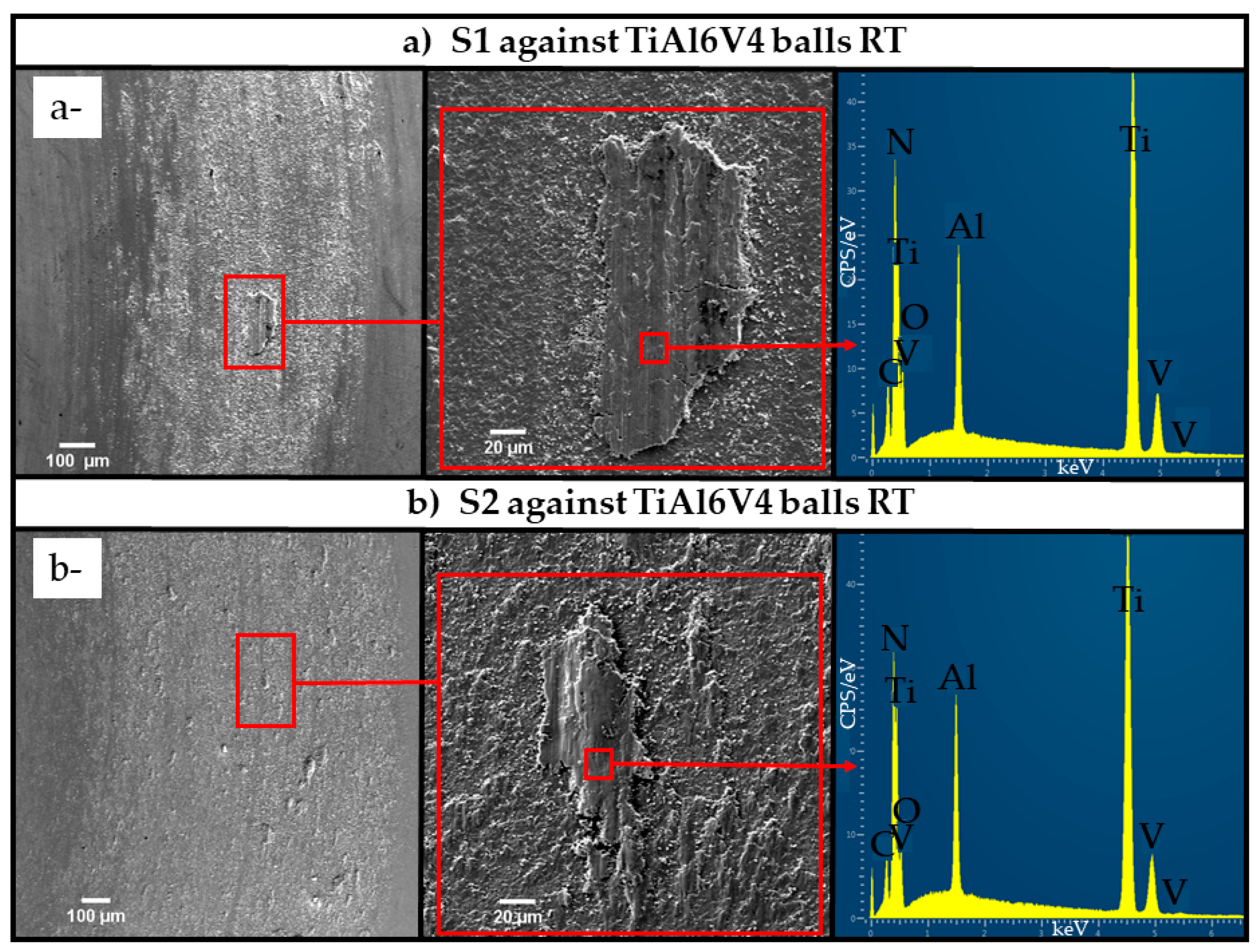Room and High Temperature Tribological Performance of Multilayered TiSiN/TiN and TiSiN/TiN(Ag) Coatings Deposited by Sputtering
Abstract
:1. Introduction
2. Materials and Methods
3. Results
3.1. Friction Coefficient
3.1.1. Al2O3 Balls
3.1.2. TiAl6V4 Balls
3.2. Specific Wear Rate of Coatings and Balls
3.2.1. Al2O3 Balls
3.2.2. TiAl6V4 Balls
4. Discussion
4.1. Al2O3 Balls
4.2. TiAl6V4 Balls
5. Conclusions
- Sliding against Al2O3 balls led to the formation of relatively smooth wear tracks at RT.
- The reference coating displayed a better performance due to its high hardness and fracture toughness as compared to the Ag-alloyed coating.
- At 550 °C, the reference coating failed, while the Ag-doped coating showed a better performance due to the presence of Ag on the contact, which decreased the shear strength and consequently the friction.
- Ag-doped coating was always better than reference coating.
- At room temperature, the wear was governed by the contact between the material from the ball adhering to the coating and the ball material, i.e., TiAl6V4 sliding against itself.
- At 550 °C, the presence of Ag at the contact prevented the adhesion of the oxidized Ti-alloy wear debris in the contact, favoring the adhesion of wear debris from the coating to both elements of the sliding pair and thus leading to a better performance.
- No wear could be observed at 700 °C for both coatings. However, whilst spikes coming out from the wear track of the reference coating could be detected, suggesting a strong adhesion wear mechanism, the wear track of the Ag-doped coating displayed a smooth surface that was almost absent of adhesion wear.
- The presence of Ag-agglomerated particles on the wear track of the TiSiN/TiN(Ag) coating decreased friction and hindered the adhesion of material to the wear track.
Supplementary Materials
Author Contributions
Funding
Conflicts of Interest
References
- Khanna, N.; Davim, J. Design-of-experiments application in machining titanium alloys for aerospace structural components. Measurement 2015, 61, 280–290. [Google Scholar] [CrossRef]
- Arrazola, P.-J.; Garay, A.; Iriarte, L.-M.; Armendia, M.; Marya, S.; Le Maitre, F. Machinability of titanium alloys (Ti6Al4V and Ti555.3). J. Mater. Process. Technol. 2009, 209, 2223–2230. [Google Scholar] [CrossRef] [Green Version]
- Dandekar, C.R.; Shin, Y.C.; Barnes, J. Machinability improvement of titanium alloy (Ti–6Al–4V) via LAM and hybrid machining. Int. J. Mach. Tools Manuf. 2010, 50, 174–182. [Google Scholar] [CrossRef]
- Çalışkan, H.; Küçükköse, M.; Çaliskan, H. The effect of aCN/TiAlN coating on tool wear, cutting force, surface finish and chip morphology in face milling of Ti6Al4V superalloy. Int. J. Refract. Met. Hard Mater. 2015, 50, 304–312. [Google Scholar] [CrossRef]
- Pramanik, A. Problems and solutions in machining of titanium alloys. Int. J. Adv. Manuf. Technol. 2014, 70, 919–928. [Google Scholar] [CrossRef]
- Filho, S.L.M.R.; Lauro, C.H.; Bueno, A.H.S.; Brandão, L.C. Influence cutting parameters on the surface quality and corrosion behavior of Ti–6Al–4V alloy in synthetic body environment (SBF) using Response Surface Method. Measurement 2016, 88, 223–237. [Google Scholar] [CrossRef]
- Veiga, C.; Davim, J.P.; Loureiro, A.J.R. Review on machinability of titanium alloys: The process perspective. Rev. Adv. Mater. Sci. 2013, 34, 148–164. [Google Scholar]
- Polishetty, A.; Goldberg, M.; Littlefair, G.; Puttaraju, M.; Patil, P.; Kalra, A. A preliminary assessment of machinability of titanium alloy Ti 6AL 4V during thin wall machining using trochoidal milling. Procedia Eng. 2014, 97, 357–364. [Google Scholar] [CrossRef] [Green Version]
- Renevier, N.; Hamphire, J.; Fox, V.; Witts, J.; Allen, T.R.; Teer, D. Advantages of using self-lubricating, hard, wear-resistant MoS2-based coatings. Surf. Coat. Technol. 2001, 142–144, 67–77. [Google Scholar] [CrossRef]
- Voevodin, A.; Muratore, C.; Aouadi, S. Hard coatings with high temperature adaptive lubrication and contact thermal management: Review. Surf. Coat. Technol. 2014, 257, 247–265. [Google Scholar] [CrossRef]
- Cavaleiro, D.; Carvalho, S.; Fernandes, F. TiSiN(Ag) films deposited by HiPIMS working in DOMS mode: Effect of Ag content on structure, mechanical properties and thermal stability. Appl. Surf. Sci. 2019, 478, 426–434. [Google Scholar] [CrossRef]
- Dang, C.; Li, J.; Wang, Y.; Yang, Y.; Wang, Y.; Chen, J. Influence of Ag contents on structure and tribological properties of TiSiN-Ag nanocomposite coatings on Ti–6Al–4V. Appl. Surf. Sci. 2017, 394, 613–624. [Google Scholar] [CrossRef]
- Fernandes, F.; Yaqub, T.; Cavaleiro, A. Influence of Ag additions on the structure, mechanical properties and oxidation behaviour of Cr-O coatings deposited by HiPIMS. Surf. Coat. Technol. 2018, 339, 167–180. [Google Scholar] [CrossRef]
- Moszner, F.; Cancellieri, C.; Chiodi, M.; Yoon, S.; Ariosa, D.; Janczak-Rusch, J.; Jeurgens, L.P.H. Thermal stability of Cu/W nano-multilayers. Acta Mater. 2016, 107, 345–353. [Google Scholar] [CrossRef]
- Li, J.-L.; Xiong, D. Tribological properties of nickel-based self-lubricating composite at elevated temperature and counterface material selection. Wear 2008, 265, 533–539. [Google Scholar] [CrossRef]
- Zhu, S.; Cheng, J.; Qiao, Z.; Yang, J. High temperature solid-lubricating materials: A review. Tribol. Int. 2019, 133, 206–223. [Google Scholar] [CrossRef]
- Aouadi, S.M.; Gao, H.; Martini, A.; Scharf, T.; Muratore, C. Lubricious oxide coatings for extreme temperature applications: A review. Surf. Coat. Technol. 2014, 257, 266–277. [Google Scholar] [CrossRef]
- Bilger, G.; Voss, T.; Schlenker, T.; Strohm, A. High-temperature diffusion barriers from Si-rich silicon-nitride. Surf. Interface Anal. 2006, 38, 1687–1691. [Google Scholar] [CrossRef]
- Al-Rjoub, A.; Cavaleiro, A.; Fernandes, F. Influence of Ag alloying on the morphology, structure, mechanical properties, thermal stability and oxidation resistance of multilayered TiSiN/Ti(Ag)N films. Mater. Des. 2020, 192, 108703. [Google Scholar] [CrossRef]
- Archard, J.F. Contact and Rubbing of Flat Surfaces. J. Appl. Phys. 1953, 24, 981–988. [Google Scholar] [CrossRef]
- Fernandes, F.; Polcar, T.; Cavaleiro, A. Tribological properties of self-lubricating TiSiVN coatings at room temperature. Surf. Coat. Technol. 2015, 267, 8–14. [Google Scholar] [CrossRef]
- Ju, H.; Yu, L.; Yu, D.; Asempah, I.; Xu, J. Microstructure, mechanical and trobological properties of TiN-Ag films deposited by reactive magnetron sputtering. Vaccum 2017, 141, 82–88. [Google Scholar] [CrossRef]
- Chang, C.-L.; Chen, W.-C.; Tsai, P.-C.; Ho, W.-Y.; Wang, D.-Y. Characteristics and performance of TiSiN/TiAlN multilayers coating synthesized by cathodic arc plasma evaporation. Surf. Coat. Technol. 2007, 202, 987–992. [Google Scholar] [CrossRef]
- Wan, Q.; Yang, B.; Chen, Y.; Cai, Y.; Liu, Y.; Meng, L.; Gao, D. Effect of bilayer period on microstructure and mechanical properties of TiSiN/TiN coatings. Materialia 2018, 3, 260–264. [Google Scholar] [CrossRef]
- Köstenbauer, H.; Fontalvo, G.A.; Mitterer, U.-P.D.-I.D.M.C.; Keckes, J. Tribological properties of TiN/Ag nanocomposite coatings. Tribol. Lett. 2008, 30, 53–60. [Google Scholar] [CrossRef]
- Dang, C.; Dong, M.; Li, J.-L. Influence of annealing temperature on film morphology and tribological performance of TiSiN–Ag coating. Mater. Res. Express 2019, 6, 096446. [Google Scholar] [CrossRef]
- Cavaleiro, D.; Veeregowda, D.; Carvalho, S.; Fernandes, F. High temperature tribological behaviour of TiSiN(Ag) films deposited by HiPIMS in DOMS mode. Surf. Coat. Technol. 2020, 399, 126176. [Google Scholar] [CrossRef]
- Fan, Y.; Tian, W.; Guo, Y.; Sun, Z.; Xu, J. Relationships among the microstructure, mechanical properties, and fatigue behavior in thin Ti6Al4V. Adv. Mater. Sci. Eng. 2016, 2016, 7278267. [Google Scholar] [CrossRef] [Green Version]
- Bandyopadhyay, B. Mechanism of formation of built-up edge. Precis. Eng. 1984, 6, 148–151. [Google Scholar] [CrossRef]








| Sample Designation | TiSiN/TiN | TiSiN/TiN(Ag) |
|---|---|---|
| Chemical composition (at.%) | Ti—46.1 | Ti—42.3 |
| Si—4.6 | Si—4.3 | |
| N—49.3 | N—50.2 | |
| – | Ag—3.2 | |
| Hardness (H) (GPa) | 26 ± 4 | 18 ± 4 |
| Reduced modulus (E) (GPa) | 334 ± 28 | 286 ± 23 |
| Elastic strain to failure—H/E | 0.078 | 0.062 |
| Onset point of oxidation (°C) | 700 °C | 700 °C |
| Oxidation weight gain at 800 °C for 2 h mg/cm2 | 0.025 | 0.16 |
Publisher’s Note: MDPI stays neutral with regard to jurisdictional claims in published maps and institutional affiliations. |
© 2020 by the authors. Licensee MDPI, Basel, Switzerland. This article is an open access article distributed under the terms and conditions of the Creative Commons Attribution (CC BY) license (http://creativecommons.org/licenses/by/4.0/).
Share and Cite
Fernandes, F.; AL-Rjoub, A.; Cavaleiro, D.; Polcar, T.; Cavaleiro, A. Room and High Temperature Tribological Performance of Multilayered TiSiN/TiN and TiSiN/TiN(Ag) Coatings Deposited by Sputtering. Coatings 2020, 10, 1191. https://doi.org/10.3390/coatings10121191
Fernandes F, AL-Rjoub A, Cavaleiro D, Polcar T, Cavaleiro A. Room and High Temperature Tribological Performance of Multilayered TiSiN/TiN and TiSiN/TiN(Ag) Coatings Deposited by Sputtering. Coatings. 2020; 10(12):1191. https://doi.org/10.3390/coatings10121191
Chicago/Turabian StyleFernandes, Filipe, Abbas AL-Rjoub, Diogo Cavaleiro, Tomas Polcar, and Albano Cavaleiro. 2020. "Room and High Temperature Tribological Performance of Multilayered TiSiN/TiN and TiSiN/TiN(Ag) Coatings Deposited by Sputtering" Coatings 10, no. 12: 1191. https://doi.org/10.3390/coatings10121191








